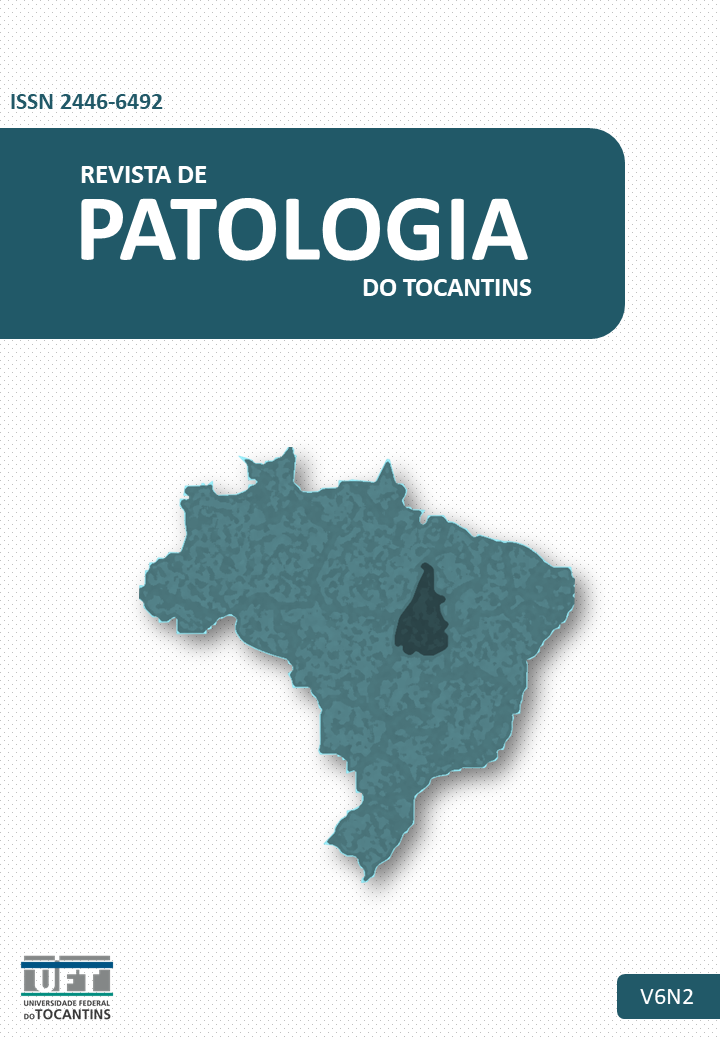PERFIL EPIDEMIOLÓGICO DO CÂNCER DE PÂNCREAS NA REGIÃO NORTE DO BRASIL NO PERÍODO DE 2010 A 2018.
DOI:
https://doi.org/10.20873/uft.2446-6492.2019v6n2p20Resumo
Objetivo: O câncer de pâncreas possui alta taxa de mortalidade e uma baixa taxa de sobrevida, sendo o estudo de sua epidemiologia fundamental para o desenvolvimento de políticas que favoreçam o diagnóstico precoce. Dessa forma, o objetivo do presente estudo é descrever o perfil epidemiológico dos pacientes diagnosticados com câncer de pâncreas na região Norte do Brasil no período de 2010 a 2018. Método: O estudo epidemiológico apresenta natureza descritiva e foi realizado por meio da coleta de dados disponíveis no Departamento de Informação e Informática do SUS (DATASUS) no período de 2010 a 2018 dos sete estados da Região Norte do Brasil. Verificou-se o número total, por sexo e idade de casos de neoplasias malignas do pâncreas. Resultados: Foram encontrados 2.080 casos durante o período analisado, percebendo-se um aumento significativo na incidência dessa neoplasia na região. O número de internações foi maior em indivíduos com 60 anos ou mais e no sexo masculino, com exceção dos estados do Amazonas e Pará em que foi maior no sexo feminino. O estado de Rondônia apresentou um maior aumento da taxa de incidência, que passou de 0,84 em 2010 para 5,88 em 2018, enquanto no Amapá observou-se um decréscimo desse valor (de 1,75 para 1,48). Conclusão: A incidência dos casos na região Norte dobrou no período avaliado sendo, em geral, mais comum em homens com 60 anos ou mais. No ano de 2018, a incidência no estado de Rondônia ultrapassou as estimativas mundiais para esse câncer. Destaca-se a importância dos dados encontrados por esse estudo que podem contribuir com o desenvolvimento de medidas de saúde pública relacionadas ao tema.
Palavras-chave: Neoplasias pancreáticas; Epidemiologia; Incidência.
ABSTRACT
Objective: Pancreatic cancer has a high mortality rate and a low survival rate, and its epidemiology study is fundamental for the development of policies that will favor an early diagnosis. Thus, the objective of the present study is to describe the epidemiological profile of patients who were diagnosed with pancreatic cancer in the northern region of Brazil from 2010 to 2018. Method: The epidemiological study is descriptive and was performed through the collection of available data in the Electronic Information Department of SUS (DATASUS), from 2010 to 2018 including seven states of the Northern Region of Brazil. The total number, by sex and age, of cases of malignant neoplasms of pancreas was verified. Results: A total of 2080 cases were found during the analyzed period, with a significant increase in the incidence of this neoplasia in the region. The number of hospitalizations was higher in individuals who were 60 years of age or older and males, except for the states of Amazonas and Pará, where it was higher among females. The state of Rondônia presented a higher increase in the incidence rate, which increased from 0.84 in 2010 to 5.88 in 2018, while in Amapá there was a decrease of this value (from 1.75 to 1.48). Conclusion: The incidence of cases in the Northern region doubled in the evaluated period and, in general, it is more common in men aged 60 years or older. In 2018, the incidence in the state of Rondônia exceeded the world estimates for this cancer. The importance of the data found by this study is of grand importance once that may contribute to the development of public health measures related to the theme.
Keywords: Pancreatic Neoplasms; Epidemiology; Incidence.
Downloads
Publicado
Como Citar
Edição
Seção
Licença
Os autores declaram para os devidos fins de direito e obrigações, sob as penas previstas na Legislação vigente, que são autores/detentores dos Direitos Autorais do trabalho proposto nos termos dos artigos 28 a 33 da Lei Federal nº9.610 de 19 de fevereiro de 1998 (Lei dos Direitos Autorais).








